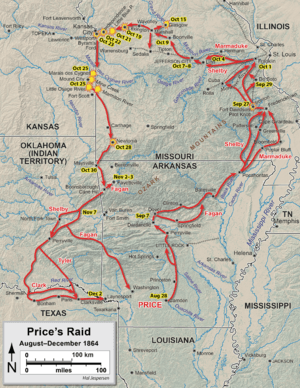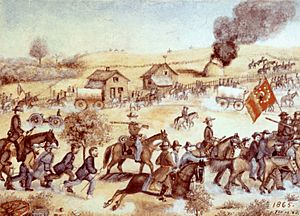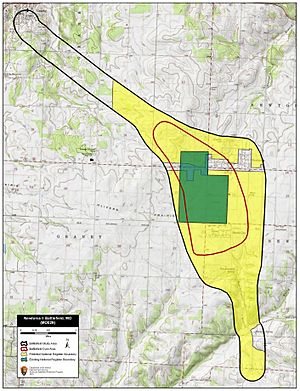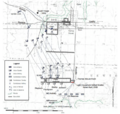Second Battle of Newtonia facts for kids
Quick facts for kids Second Battle of Newtonia |
|||||||
|---|---|---|---|---|---|---|---|
| Part of Price's Raid during the American Civil War |
|||||||
 Field south of Newtonia, near the eastern edge of the fighting |
|||||||
|
|||||||
| Belligerents | |||||||
| Commanders and leaders | |||||||
| James G. Blunt | Joseph O. Shelby | ||||||
| Strength | |||||||
| 1,500 or 2,000 | 2,000 or 3,500 | ||||||
| Casualties and losses | |||||||
| 26–400 | 24–275 | ||||||
The Second Battle of Newtonia was a fight during the American Civil War. It happened on October 28, 1864, near Newtonia, Missouri. This battle was part of a larger plan called Price's Raid. In this raid, Confederate General Sterling Price tried to start a rebellion against Union control in Missouri.
Price's army had faced several defeats. They lost battles at Pilot Knob and Battle of Westport. After these losses, Price's tired army stopped to rest near Newtonia on October 28. Union soldiers, led by General James G. Blunt, caught up with them. The battle started when Blunt's troops pushed back the Confederate skirmishers (soldiers sent ahead to scout and fight lightly).
General Price ordered his main army to retreat. He told General Joseph O. Shelby to stay behind with a rear guard (a group of soldiers protecting the main army's retreat). Shelby's troops were stronger at first. They tried to go around Blunt's army. Blunt's men were running low on bullets. He was thinking about retreating when Union reinforcements arrived. General John B. Sanborn and his soldiers joined the fight. The Union troops then attacked again. Shelby had to order his men to retreat. The Union army chased them for a while. The Confederates kept retreating all the way to Texas. Price lost many soldiers during this campaign. Even though both sides first said they won, historians today agree that the Union won the Second Battle of Newtonia.
Contents
Why the Battle Happened
When the American Civil War began in 1861, Missouri was a state where slavery was allowed. But it did not leave the United States. The state was divided. Some people, like Governor Claiborne Fox Jackson, supported the Confederate States of America. Others, like General Nathaniel Lyon, supported the Union Army.
By 1862, the Union had control of Missouri. After this, most fighting in Missouri was small attacks and raids.
In September 1864, the war was going badly for the Confederates in the eastern United States. Confederate General Edmund Kirby Smith wanted to help. He decided to send an army into Missouri. This would make the Union send troops to Missouri, taking them away from other important battles. General Price was chosen to lead this attack. Price hoped that people in Missouri would rise up and join his army. He also hoped it would help George B. McClellan win the 1864 election against Abraham Lincoln, as McClellan wanted to end the war. On September 19, Price's army entered Missouri.
Price's army first wanted to capture St. Louis. But they lost a battle at Pilot Knob. So, they decided not to attack St. Louis. Their next target was Jefferson City, Missouri. But it was too strong. So, Price's army moved west towards Kansas City, Missouri.
On October 23, Union General Samuel Ryan Curtis and his army caught Price near Kansas City. They badly defeated Price's army at the Battle of Westport. Price's army then started retreating through Kansas. They lost three more battles on October 25. One of these was the Battle of Mine Creek, where many Confederate soldiers were captured.
Price's army was very tired and many soldiers were leaving. On October 28, Price stopped his retreat near Newtonia, Missouri. This was the same place where the First Battle of Newtonia happened in 1862. Price wanted his men to rest. There was also food for his horses and men in the area. A small Union outpost was in Newtonia. Confederate soldiers drove them out. One Union soldier, Lieutenant Robert H. Christian, was captured and killed.
The Battle Begins
Price's men camped south of Newtonia. Some soldiers went into town to use a flour mill. A report came that Union soldiers were coming. General M. Jeff Thompson tried to get his soldiers ready. But many Confederates were too tired to fight. Thompson only got about 200 men to follow him. When no Union soldiers showed up, Thompson sent his men back to camp.
Around 2:00 PM, Union soldiers led by Colonel James Hobart Ford arrived. They came from the northwest. Ford set up his cannons and cavalry (soldiers on horseback). The Confederates were gathering corn when the Union troops arrived. Their skirmishers (scouts) were quickly pushed back from the Mathew H. Ritchey Farm. Union General James G. Blunt arrived and took command. He even fought with his soldiers.
Price was surprised. He thought General Curtis's whole army was attacking him. He ordered General Joseph O. Shelby to form a rear guard. This meant Shelby's men would fight to protect the main army as it retreated. Price could not send Shelby any more soldiers. Shelby's group was the only strong part of the Confederate army left. Blunt also made a mistake. He thought Curtis was right behind him to help. He also thought the Confederates would not fight hard. So, Blunt attacked with only about 1,000 men.
Fighting at McClain Farm
The Union cavalry moved to the northern edge of the McClain Farm. They formed a line with four cavalry groups. Their cannons were set up behind them. Shelby's Confederates were about 500 yards away on the other side of the farm. They had two groups of soldiers in the middle and small groups on the sides. They also had two cannons.
The cannons on both sides started firing. The Confederate cannons were better at first. The distance was too far for regular guns to do much. The Union brought in more cannons. Shelby worried that the Union's many cannons would win. So, he ordered an attack. His men went around the side of the Union line. This flanking maneuver worked at first. The Union soldiers fell back about 200 yards. Only Thompson's group attacked. One Confederate officer, Colonel Moses W. Smith, was badly wounded.
The Union cannons helped hold their right side. But on the Union left side, Confederate soldiers went around them. This made the Union cannons retreat. General Blunt had ordered an organized retreat. But seeing the cannons leave made some Union soldiers run away. The Confederates pushed harder. The Union lines fell back to the Ritchey Farm. They regrouped there. Two companies of Union cavalry then charged. This surprised the Confederates and made them confused for a moment.
Blunt was worried his men would run out of bullets. He was getting ready to leave the battlefield. It was almost sunset. Around 5:00 PM, Union reinforcements arrived. General John B. Sanborn and his men had marched quickly to join Blunt. Sanborn's men joined on Blunt's left side. Now, there were about 1,500 to 2,000 Union soldiers fighting.
General Curtis arrived with Sanborn. He saw Blunt's cannons retreating. Curtis helped rally the Union soldiers. Sanborn's men got off their horses and prepared to attack. When Sanborn's men attacked, Blunt's soldiers joined in. More Union cannons arrived, giving them eight cannons to the Confederates' two. With fresh troops and more cannons, Shelby ordered his men to retreat. The Union counterattack pushed the Confederates back about one mile. Both sides were very tired. Curtis and Blunt decided to wait until morning to chase them.
After the Battle
Both armies claimed they won the battle. General Curtis said the Confederates were "conquered." General Price said Blunt had been pushed back three miles. But historians today agree it was a Union victory.
The number of soldiers hurt or killed is hard to know for sure. One newspaper said 113 Union soldiers were hurt and fewer than 200 Confederates. Some historians say Union losses were around 114, and Confederate losses were similar or less. It is known that 46 wounded Confederates were captured by Union troops. They were left behind because Price's army could not carry them. Several houses in Newtonia were used as hospitals for the wounded.
After the battle, most of Shelby's men left to rejoin Price's main army. They had done their job of protecting the retreat. Price's army was falling apart. General Ulysses S. Grant ordered Union troops not needed to fight Price to go east of the Mississippi River. So, some of Curtis's troops were sent away. But they were sent back the next day. The Union chase continued. Price's army retreated all the way to Texas. Price lost more than two-thirds of his soldiers during the whole campaign.
The battlefield is now a protected historic site. It was added to the National Register of Historic Places in 2004. Many areas where the fighting happened are preserved. The land today looks similar to how it did in 1864. The American Battlefield Trust has helped save 8 acres of the battlefield.
Images for kids












